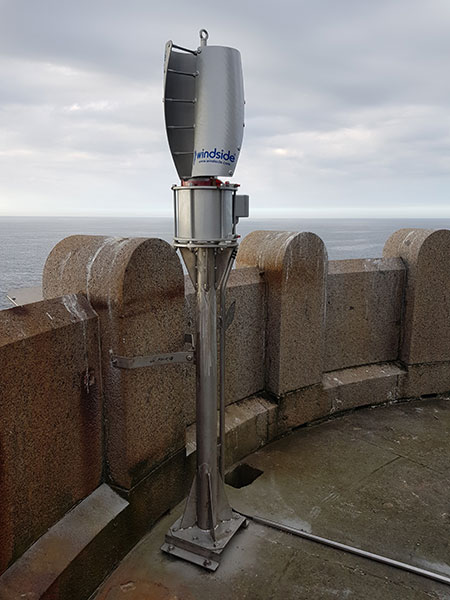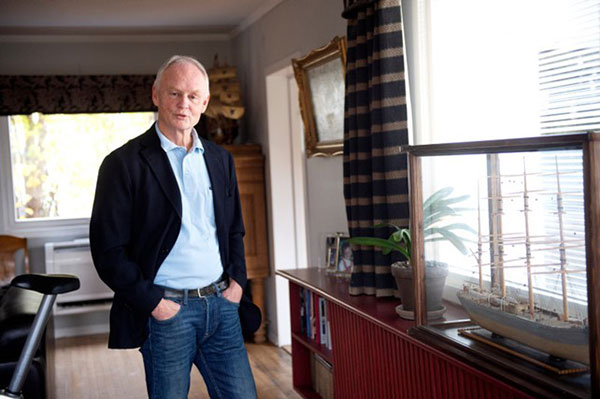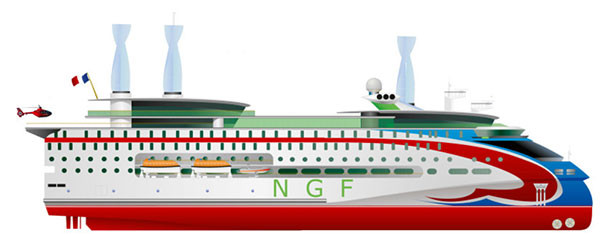Equipment
Wind powers vessels

Photos above: Le Four in northern Finistère Windside WS-0,15B installed 2021. Photo by: Direction Interrégionale de la Mer Nord Atlantique Manche Ouest.
Wind turbines in vessels is not a new invention. Savonius Rotor was invented by a Finn, Sigurd Savonius in 1926, almost 100 years ago. Operation of his invention is based on Magnus effect and Flettner law; very familiar to people involved in sailing.
The same physics laws are prevailing in Windside turbine,
born 1982 in Finland by Risto Joutsiniemi. Due to shape and
some mechanical differences, Windside has many advantages over
Savonius rotor, e.g. totally soundless operation and utmost durability
producing energy also in storms.
After working over 40 years with Windside turbines, Mr.
Joutsiniemi
describes that “a long journey has been just as a day
of small beginnings; future is at sea”. – Despite the growing interest
today from building industry.
“As Windside turbines are strong enough to face storms
seen by lighthouse Le Four in France, or McMurdo base station
in Antarctica, they surely can stand and produce safe electricity
also on vessels,” Mr. Joutsiniemi says.

Windside WS-0,15B installed 2021.
Civil engineer Per Kavli and the company Green Ships in
Oslo are behind the projects for designing boats using only renewable
energy as energy source.
Mr. Kavli says: “Environmental requirement and regulations in maritime sector
are under big changes. The whole shipping industry is looking
for new power plant solutions and the ultimate goal is to obtain
ZERO NOX and CO2 emissions.
This has resulted in the use of some new fuel options: Hydrogen,
ammonia, methanol, fuel cells and also LNG (which is not
really a fossil free option, but in some ways better than MDO).
One way to reduce emissions is to use free energy from wind
and sun. Wind turbines are a good alternative, as they can work
24h/day/365 days/year, and require less space.”

Civil engineer Per Kavli. Photo: Iván Kverme.
“They can work as roll reduction units, due to the «Gyro
effect», which to some extent can substitute expensive active roll
reduction fins. Also, when the vessel is moving, it creates something
called the «Magnus effect», which reduces the ships wind
resistance.”
Mr. Kavli describes a new modern hybrid ship:
“The 160 m medium size cruise ship is designed for operation
in the Norwegian world heritage fjords, where ZERO emission
is a mandatory requirement, from 1.1.2016 onwards. This
ship will use a combination of fuel cells, large size batteries, and
5 large size Windside wind turbines. The same concept can and
will be used in many types of ships, such as Ropax ferries, offshore
ships, etc.”
Mr. Kavli estimates that from the day one, the ships will
reduce emissions ca. 70% compared to existing tonnage, and
later on even more.

In the future, Mr. Kavli sees a large market for environmentally
friendly cruise, tourism and ferry traffic. Authorities in several
countries are keen for new ferry connections, to be operated with
low-emission ferries that generate minimum noise.
“New Hybrid ships that do not use fossil fuels is the future.
It makes sense to use wind turbines as they are suitable for most
types of ships. Also good for roll reduction purposes, typically
where there are passengers on board,” he says.
Green Ships AS is an Oslo-based maritime consulting firm owned
by Per Kavli’s family company, Kavli Eiendom.
More information:
www.windside.com
general@windside.com



